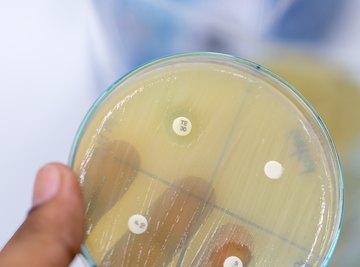
Prokaryotes such as bacteria don’t have much of a sex life. Most prokaryotic species don’t participate in sexual reproduction and have only one copy of each gene on their single lonely chromosome. Sexually reproducing organisms have two sets of chromosomes, one set from each parent, and therefore have two versions of each gene.This arrangement increases genetic diversity. However, bacteria have found ways to increase their genetic diversity through three recombination techniques: transduction, transformation and conjugation.
What is Genetic Recombination?
Organisms evolve because of changes to their genomes, the DNA sequences that code for proteins and RNAs. Mutations to DNA can occur at any time and might change the structure of the proteins produced. Prokaryotes have additional ways to evolve their genomes besides relying on relatively infrequent mutations. Through genetic recombination, individual prokaryotic cells can share DNA with other individual cells, not necessarily belonging to the same species. This can help spread a beneficial gene that produces heartier organisms. For example, the appearance of a gene that confers antibiotic resistance might create a virulent strain of bacteria. The cells may spread the beneficial gene through genetic recombination, helping to ensure the survival of the species.
Transduction
Transduction is the transfer of DNA from one bacterium to another through the action of viruses. When a virus infects a bacterium, it injects its genetic material into its victim and highjacks the bacterium’s machinery for synthesizing DNA, RNA and proteins. Sometimes, the viral genetic material joins with the host’s DNA. Later, the viral DNA excises itself from the bacterium’s chromosome, but the process is imprecise and bacterial genes might be included with the newly freed viral DNA. The virus causes the host to replicate many copies of the virus genome along with any host genes along for the ride. The virus then causes the cell to rupture, releasing new virus particles that repeat the cycle. In this way, genes from one host combine with those of another host, perhaps from another species.
Transformation
Certain species of bacteria can ingest DNA segments, known as plasmids, from their surroundings and incorporate the plasmids into their own chromosomes. The bacterium must first enter a special state, called competence, that allows transformation to occur. To achieve competence, the bacterium must activate a number of genes that express the required proteins. Bacteria usually transform DNA of the same species. Scientists use transformation to introduce foreign DNA into prokaryotic cells by incorporating the DNA in the growth medium. In this way, researchers can gauge the effects of different DNA segments and even create designer microorganisms with desired traits.
Conjugation
Conjugation is the bacterial equivalent of sex. It involves physical contact between two cells, possibly via a bridging structure called a pilus. Donor cells must contain a small DNA segment called the F-plasmid, which the recipient must lack. The donor cell provides a single strand of DNA from the F-plasmid and transfers it to the recipient. The enzyme DNA polymerase then synthesizes a complementary strand to produce the normally two-stranded DNA structure. In some cases, the donor also contributes chromosomal DNA beyond that of the F-plasmid. The recipient combines the donor DNA with its own genome.
About the Author
Based in Greenville SC, Eric Bank has been writing business-related articles since 1985. He holds an M.B.A. from New York University and an M.S. in finance from DePaul University. You can see samples of his work at ericbank.com.
